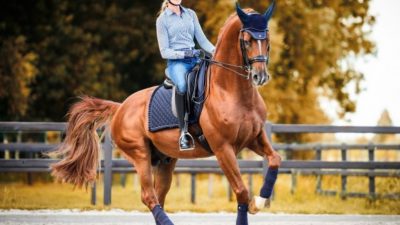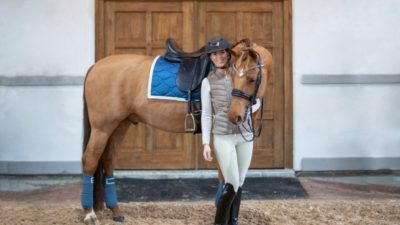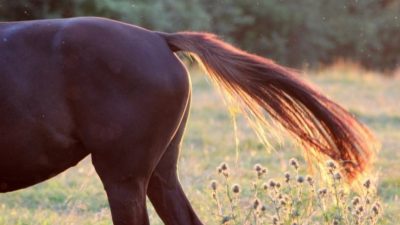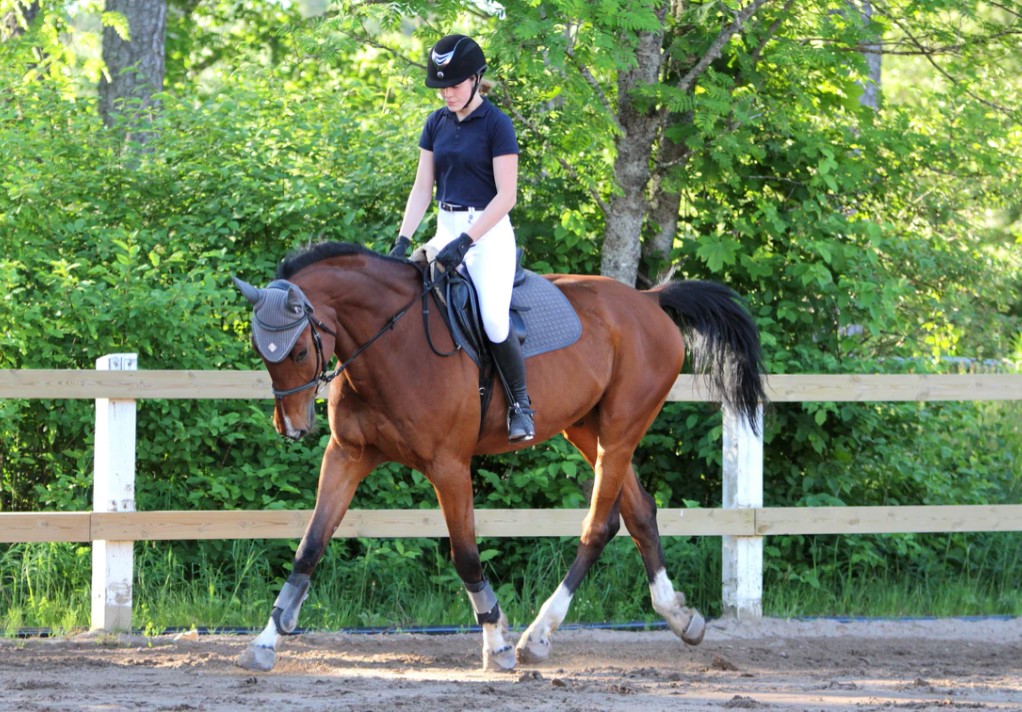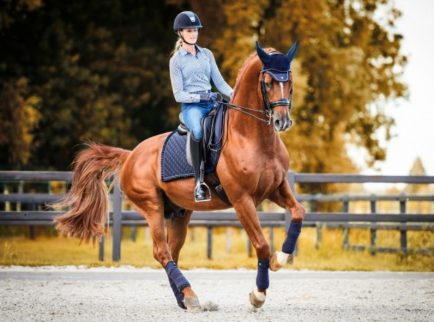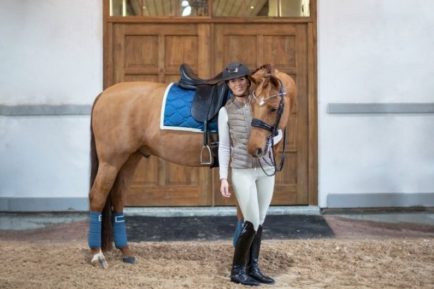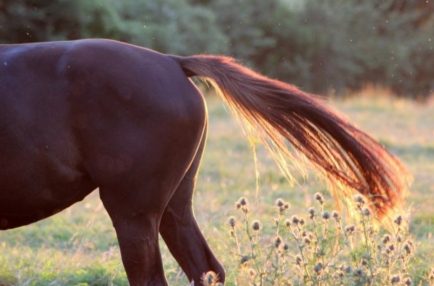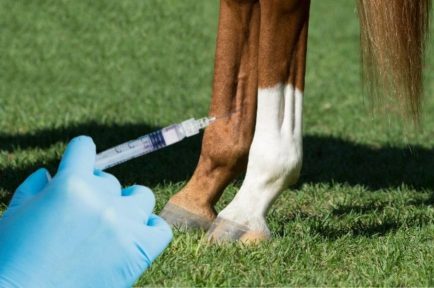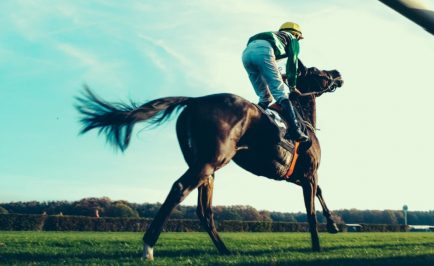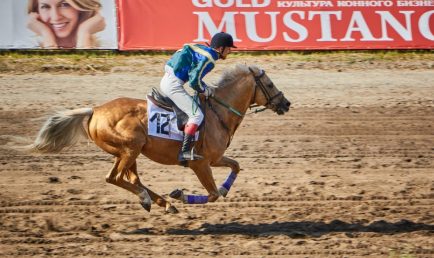What is a half halt? Half halts balance your horse by keeping him straight and in the correct frame: not too high, too low, too long or too short. From the first moment you sit on a 3-year-old, you need half halts. Then, throughout your horse’s entire career, balancing half halts help him develop his body correctly. Horses are all different; some need to be pushed forward and others need to be kept from running, but frequent half halts balance all horses.
Although a book could be written about the half halt, the most important thing to remember is what not to do. The most common problems occur because riders half halt primarily with the hand. Even though half halts are often referred to (even in this article) as being done with one or both hands, they always start with the pushing aids of the leg, weight and upper body—combined with a steady hand. That is what improves the horse’s balance—which is the result you want.
The Half Halt Rein Aids
In Germany, dressage students learn four different rein aids. The first two rein aids are not the ones you use in a half halt. The third aid is the one normally used in a half halt, and the fourth is the one used for a stronger half halt when the normal half halt doesn’t work.
All riders should be educated about these rein aids. When the rider half halts, he pushes against a steady hand, which closes the horse’s frame from behind without shortening the neck.
Half halts transform the forward motion of the horse into a more uphill carriage. They collect the horse more and more. For example (refer to the photos at left):
1. To go from medium trot (see photo on p. 30) to collected trot, push against a steady hand, and your horse should collect. Because the rider’s hand doesn’t open, the horse can’t go forward so he goes uphill.
2. To go from collected trot to passage, you want your horse even more uphill, so you push and keep your hands steady again, which closes the horse’s frame even more, and your horse comes to passage.
3. Finally, to transform the energy into the most uphill carrying power—the piaffe—you push against your hand again to half halt, and bring your legs back a little to tell your horse not to go forward in the passage, but to come on the spot.
Usually you should half halt with one hand, but under some circumstances you should half halt with both hands. Here’s how to know:
A right half halt affects the right hind leg by adding weight to it, and the same is true on the left. It’s important to realize that because it explains why, on figures and movements with bend, one does the half halt on the outside rein.
On any bent line or movement with bend, the horse’s inside hind leg naturally carries the most weight. To balance the horse so he engages and carries equal weight with each hind leg, the rider half halts with the outside rein. The rider is also soft on the inside so the inside hind leg can move forward and engage easily. Horses learn this very early in their training—as soon as 20-meter circles are introduced.
The same principle is true later for movements with bend such as half pass. Because the horse is on the outside rein, it’s easy for the inside leg to step under, and the half halt works on the outside hind leg so the horse carries equal weight behind.
The canter is an asymmetrical gait because the horse always has a leading leg and flexion on the same side. As a result, canter work is another situation in which there is always an inside that naturally carries more weight and an outside that needs to be engaged in order to balance the horse.
In the left lead canter (see above photo), the left hind leg moves much more forward than the right (outside) hind leg, so the rider should always put more emphasis on the outside half halt to equalize the carrying power of the hind legs in canter. Even on a straight line, you will want to half halt right in the left lead canter and vice versa.
The trot, however, is a symmetrical gait, so when your horse is trotting on straight lines, you want both hind legs to push the same, and when you want to collect, you want both hind legs to carry the same weight, so you half halt by pushing into both hands. Then, as soon as you trot onto a bent line, you, once again, want to have your horse on the outside rein so you can half halt on the outside.
For example, as you trot straight down the long side, you have equal contact and half halt to both hands, but as you approach the corner (which is a quarter of a circle), you should bend your horse by half halting him in the shape of the bend and then while he is bent, half halt with the outside rein while softening the inside in the corner.
Another example of when you would half halt with one rein is when your horse gets heavier in one hand. In that case, you would want to push with your seat and both legs up against whichever rein is heavy to make the hind leg on the same side engage and carry more weight. Then the horse should get lighter in that hand because the hind leg carries more.
If you ask your young horse to stretch, he should follow the rein down as you keep the same steady contact. The half halts that balance your horse in a stretch are not really classical half halts because they don’t add weight to the hind legs. On the other hand, when the rider is required to totally give the rein in Uberstreichen on a circle, half halts balance the horse, keeping weight on or adding weight to the hind legs so the horse is in self-carriage without the help of the rein.
When my horse is moving in balance, my half halts are so light and easy that no one from the outside can see that I’m doing anything. But even in this good balance, I still need to give my horse little reminding half halts every few meters. For example, if my horse is inclined to get a little too low in the neck, I push him with light half halts against the hand, which has the effect of pushing him up. These half halts say, Come on, carry yourself. A little more up. Don’t go onto your front legs. Whether my horse gets too slow, too strong, too low or too fast, my light half halts help him balance.
These light half halts are nearly invisible, so I might ride down much of the long side, appearing to do very little. Then before the corner, I start to give half halts in the shape of the bend. The corner is a quarter of a volte, so my horse must flex to the inside and bend. I try to keep him on the outside rein and stay soft on the inside as I do my corner. After the corner, I go straight again for about 10 meters on the short side, and then I prepare for my next corner with another half halt in bend.
I make these half halts as light as possible, and if my horse is “through,” they will be effective and no one will be able to see them. If, however, I don’t get a reaction from my half halt, I need to use a stronger half halt. Then, it’s most important that after every strong half halt, I try for a very light one again, which ensures that my horse stays sensitive to light aids. When he responds positively to the light aid by becoming light, I give him immediate feedback by being light with my hand. The strong half halt makes the horse sensitive to the light half halt and the light half halt keeps him
When the rider prepares for a pirouette, she pushes with her seat and both legs against the steady outside rein. The more she pushes against it, the more her horse should sit in collection. With correct flexion and bending to the inside, the inside hind leg takes the most weight of all—at times carrying the whole horse. The inside rein is light but not vacant. The rider engages the outside hind with the outside half halt and turns her horse with the outside aids.
Original article: The Half Halt Simplified (dressagetoday.com)
Royal Equestrian – Riding Apparel, Horse Fashion, Horse Tack (royalequestriancollection.com) – check our website to purchase and enjoy our products for your horses and you.









